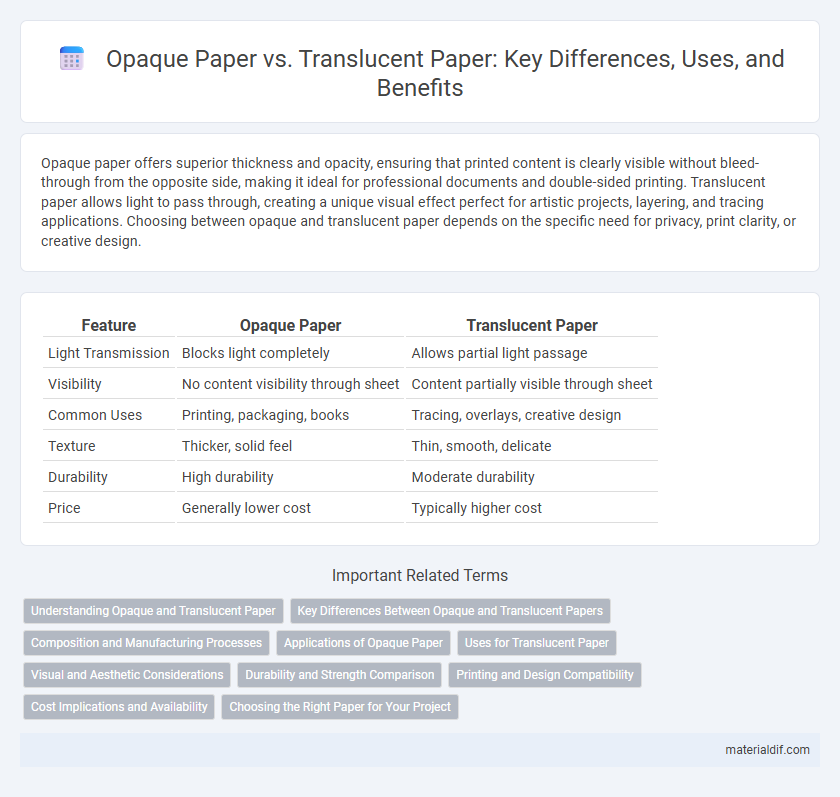Opaque paper offers superior thickness and opacity, ensuring that printed content is clearly visible without bleed-through from the opposite side, making it ideal for professional documents and double-sided printing. Translucent paper allows light to pass through, creating a unique visual effect perfect for artistic projects, layering, and tracing applications. Choosing between opaque and translucent paper depends on the specific need for privacy, print clarity, or creative design.
Table of Comparison
| Feature | Opaque Paper | Translucent Paper |
|---|---|---|
| Light Transmission | Blocks light completely | Allows partial light passage |
| Visibility | No content visibility through sheet | Content partially visible through sheet |
| Common Uses | Printing, packaging, books | Tracing, overlays, creative design |
| Texture | Thicker, solid feel | Thin, smooth, delicate |
| Durability | High durability | Moderate durability |
| Price | Generally lower cost | Typically higher cost |
Understanding Opaque and Translucent Paper
Opaque paper blocks light completely, making it ideal for printing double-sided documents without bleed-through or showing text from the reverse side. Translucent paper allows some light to pass through, often used in artistic applications like tracing, overlays, and design drafts where partial visibility enhances creativity. Understanding these differences helps select the right paper type based on printing needs and desired visual effects.
Key Differences Between Opaque and Translucent Papers
Opaque paper prevents light from passing through, offering higher privacy and vibrant print quality, ideal for professional documents and presentations. Translucent paper allows partial light transmission, creating a delicate and semi-transparent effect often used in overlays and craft projects. The key differences lie in opacity levels, usability for privacy, and the visual impact each paper type produces in various applications.
Composition and Manufacturing Processes
Opaque paper is composed of densely packed cellulose fibers treated with fillers like clay or calcium carbonate to minimize light transmission, resulting in high opacity and durability. Translucent paper incorporates specialized fiber treatments and thinner sheet formation techniques, often combined with synthetic additives such as plastic coatings or glassine to achieve partial light passage while maintaining strength. Manufacturing processes for opaque paper emphasize refining and compacting fibers to enhance opacity, whereas translucent paper production involves careful fiber selection and controlled calendaring to create a smooth, semi-transparent surface.
Applications of Opaque Paper
Opaque paper is widely used in printing applications where clarity and readability are crucial, such as books, brochures, and office documents, due to its high opacity preventing show-through. It is preferred in packaging for labels and product information because it maintains color vibrancy and text legibility. Additionally, opaque paper is essential in art projects and photography prints, providing a solid background that enhances image quality and detail.
Uses for Translucent Paper
Translucent paper is ideal for applications requiring partial light transmission, such as tracing, architectural drawings, and artistic overlays. Its semi-transparent quality enables precise replication and layering of images without complete obscuration. Designers and illustrators often favor translucent paper to enhance visibility of underlying sketches while maintaining a smooth drawing surface.
Visual and Aesthetic Considerations
Opaque paper offers sharp, high-contrast visuals with vibrant colors, making it ideal for detailed printing and legibility. Translucent paper allows light to pass through, creating a soft, ethereal effect that enhances layering and depth in design. Choosing between opaque and translucent paper depends on the desired mood and visual impact of the printed material.
Durability and Strength Comparison
Opaque paper exhibits superior durability and strength due to its dense fiber composition, making it resistant to tearing and wear. Translucent paper, characterized by thinner, less compact fibers, offers limited strength and is more prone to damage under stress. For applications requiring robustness, opaque paper is the preferred choice owing to its enhanced physical resilience.
Printing and Design Compatibility
Opaque paper offers superior print clarity and vibrant color reproduction due to its high opacity, preventing ink bleed-through and ensuring design precision. Translucent paper allows light transmission, which can create unique overlay effects but may reduce print sharpness and limit design compatibility with dense graphics. Designers must select opaque paper for projects demanding crisp, detailed prints and choose translucent paper when transparency-enhanced aesthetics are prioritized.
Cost Implications and Availability
Opaque paper generally costs less than translucent paper due to its simpler manufacturing processes and widespread availability in various grades for printing and packaging. Translucent paper, often made from higher-quality fibers or special coatings to allow light passage, tends to be more expensive and less readily available in bulk quantities. Businesses should consider these cost implications and regional supply constraints when selecting paper types for specific applications.
Choosing the Right Paper for Your Project
Opaque paper offers excellent print clarity and prevents text or images from showing through, making it ideal for double-sided printing and professional presentations. Translucent paper, often used for overlays and artistic effects, allows light to pass through while adding a unique visual dimension to projects. Selecting the right paper depends on your project's purpose, with opaque paper favored for readability and durability, and translucent paper chosen for creative transparency and layering.
Opaque paper vs Translucent paper Infographic

 materialdif.com
materialdif.com